- Details
- Hits: 17280
Station: Ironwood, MI
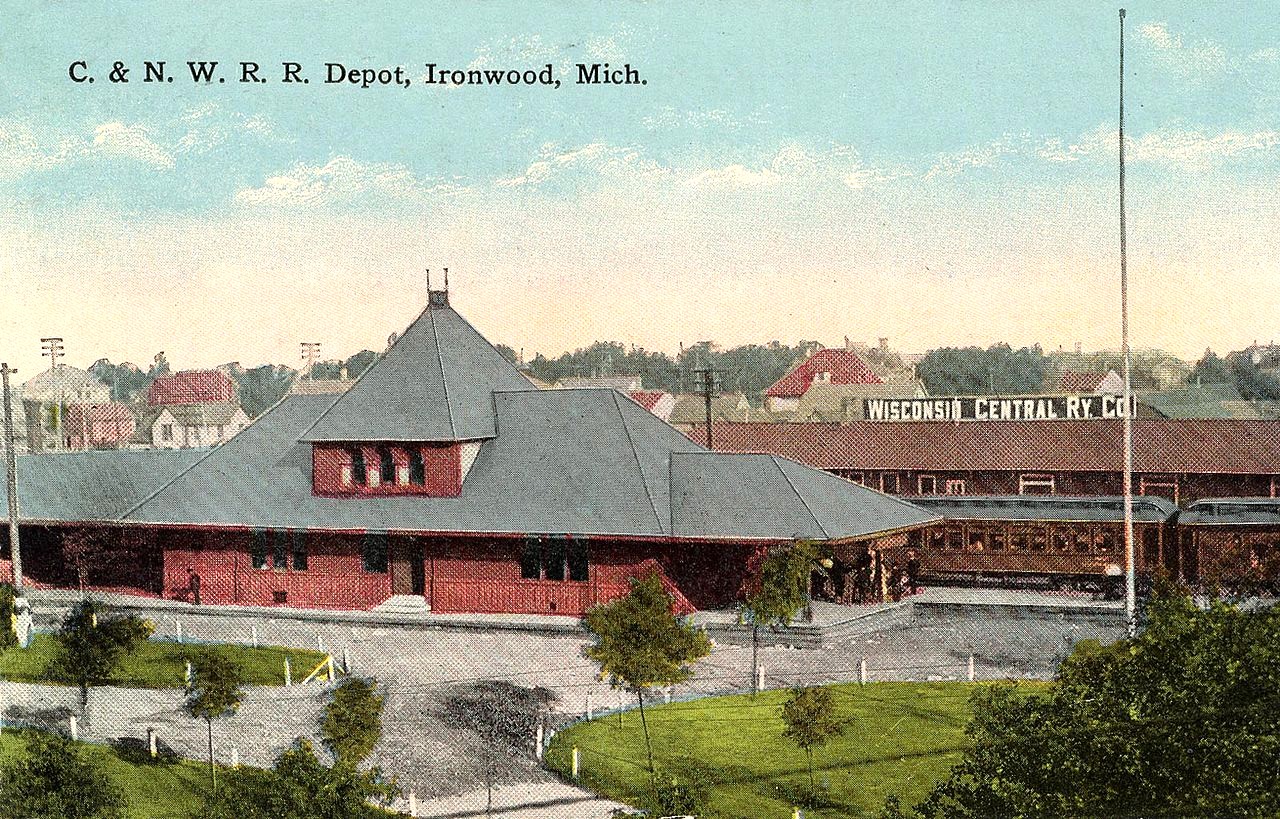
[AlanLoftisColl].webp)
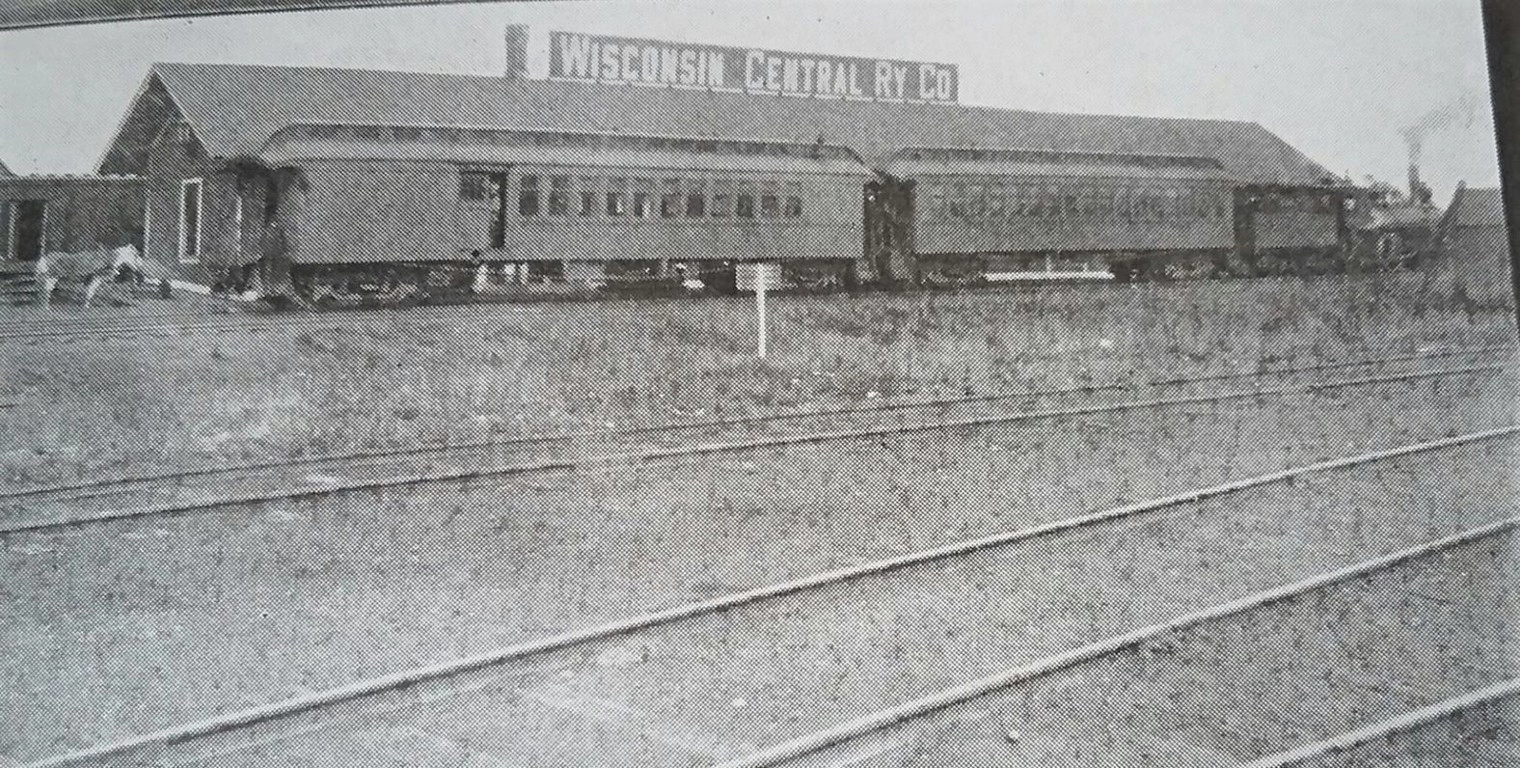
WinterRailroadingIronwoodMIPostcard.webp)

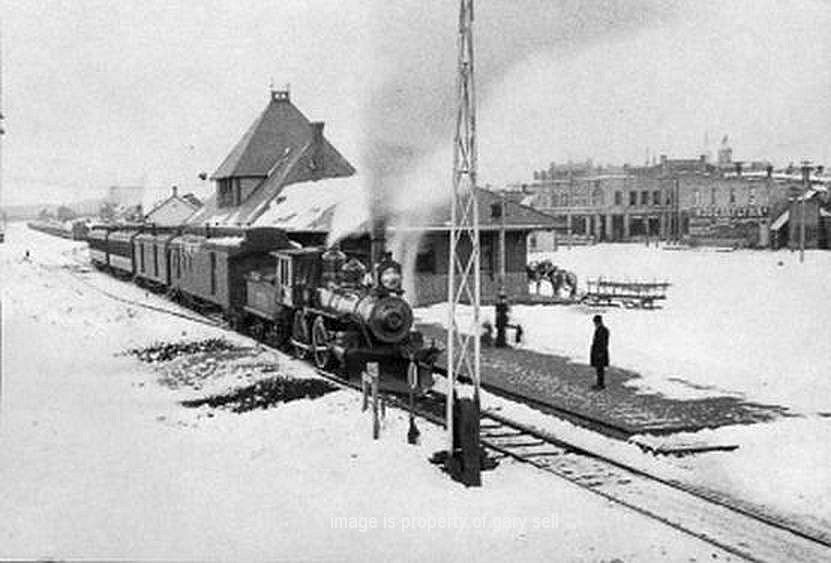
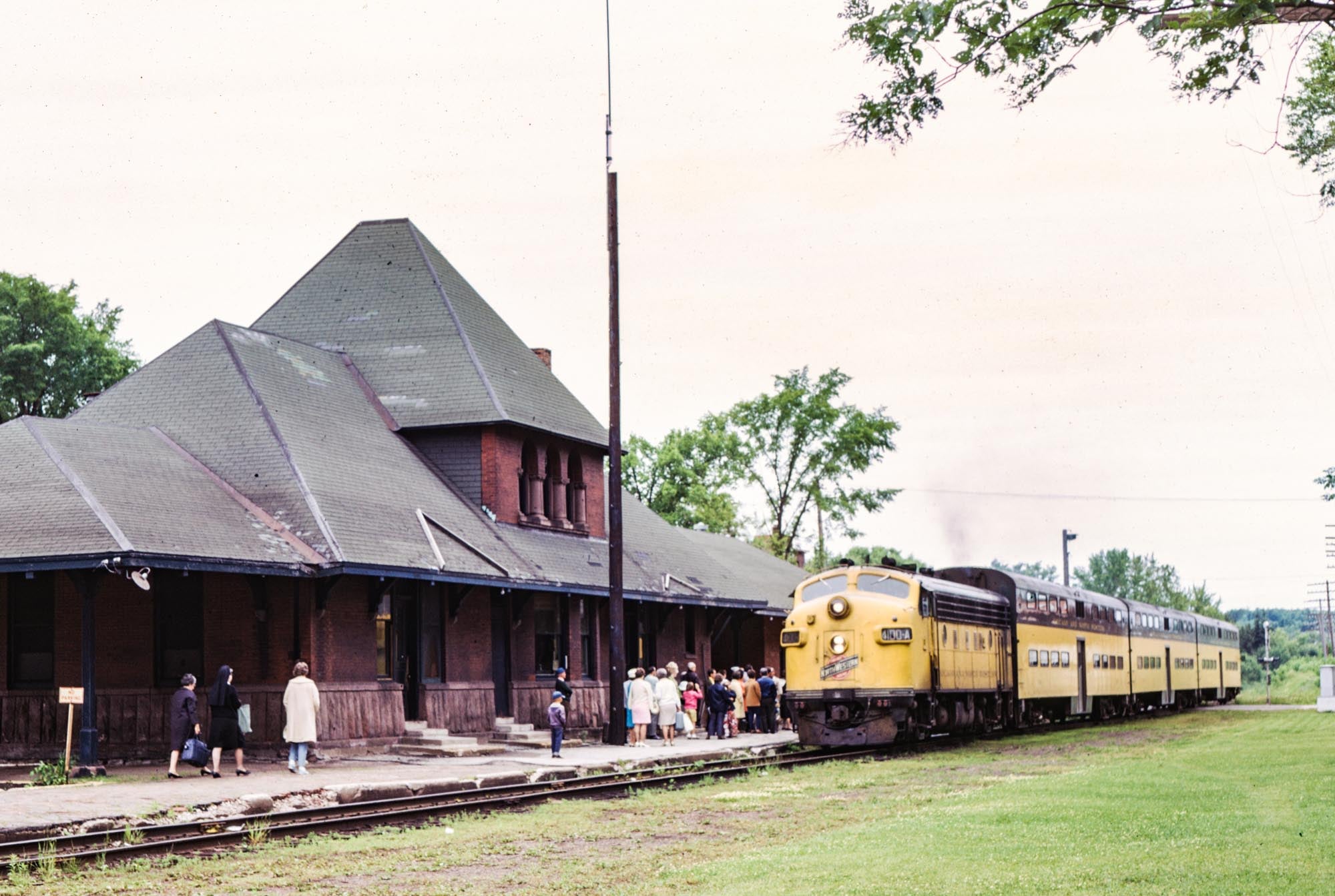
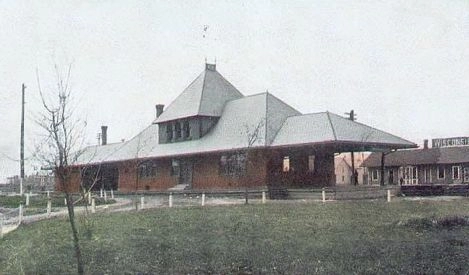
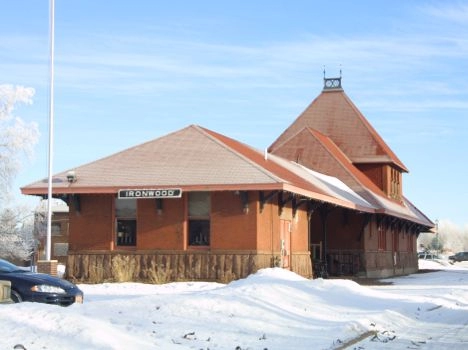 Ironwood was settled in 1885 as a commercial center around a number of iron ore mines. It became a village in 1887 and a city in 1889. [MPN]
Ironwood was settled in 1885 as a commercial center around a number of iron ore mines. It became a village in 1887 and a city in 1889. [MPN]
There were six major mines in Ironwood in 1891 including the Ashland, Aurora, East Norrie, Newport, Norrie and Pabst. The last mine closed in Ironwood in 1965.
Click here for Railroad Map.
Image info: Top, a postcard view of the C&NW Ironwood depot in 1910. the Soo Line (WC) depot at Ironwood. 2nd image, a view of the same depot in the 1950's. 3rd photo, an old view of a Wisconsin Central passenger train in front of the WC de[pt/ 4th photo, A snowbound doubleheader steam powered train in a blizzard in Ironwood in a postcard view. 5th photo, a street railway plow in Ironwood. 6th photo, an early view of the C&NW depot at Ironwood. 7th photo, The C&NW Flambeau 400 arrives eastbound at Ironwood. The train will back up to Hurley when its work at Ironwood is done. [Gregory Molloy collection]. 8th image, the C&NW (close) and Soo Line depot (far) in Ironwood. [Alan Loftis], 9th photo, the C&NW depot at Ironwood in 2003. [Dale Berry]
Notes
The Chicago & North Western railroad (formally the Milwaukee, Lake Shore & Western) built their depot here in 1892. The city had a street car line which ended at Giles, Wisconsin on the west and Bessemer on the east, including the neighboring cities of Hurley and Ironwood along the Montreal River.
Soo Line (WC) facilities included a register station and scales at this location. They had a yard, and a day/night operator in the depot in 1961. The depot was at MP 437.2.
The Soo Line railroad had a water tower in Ironwood. [SOO-W/1996]
The C&NW Ironwood Station was built in 1895. It was a brick building in Romanesque style which consists of two buildings connected by a covered passenger platform. Both structures rest on sandstone foundations five feet high and have hipped rooms with overhanging eaves supported by wooden brackets. At the northeast end of the station there is a covered passenger platform 20' by 27'. The passenger station is 27' by 90' long with a tower-like two-story portion approximately 25' long. A second covered passenger platform, 27' wide by 25' long, and the brick baggage room 27' by 30' long. [UPM]
The C&NW roundhouse in Ironwood was on Curry Street and was built about 1900. [UPM]
Time Line (including Bessemer and Wakefield):
1880. Bessemer is settled after ore is discovered at the nearby Colby mine.
1884. The Colby mine is sunk southwest of  Bessemer, reaching a depth of 1,750 feet). It is closed in 1894.
Bessemer, reaching a depth of 1,750 feet). It is closed in 1894.
1884. The Milwaukee, Lake Shore & Western (MLS&W) railroad reaches Ironwood from Watersmeet. This company becomes the Chicago & Northwestern (C&NW) in 1893.
1884. Wakefield is settled on the south side of Sunday Lake. Ramsey, southeast of Bessemer is also settled with a saw mill located there. The town was originally called Ironville. The Sunday Lake mine is established and ships for 77 years, closing in 1961.
1884. The MLS&W builds a 1.8 mile branch line to the Colby mine. (Pulled up in 1887).
1885. Ironwood is settled around several nearby mines. The Norrie and East Norrie Mines begin operations with production until 1935.
1885. The MLS&W installs a 8 mile long branch from Wakefield north to Connorsville, mostly for logging purposes. They also build off this branch to the Sunday Lake Mine, and in 1890 to the Castile and Meteor mines. The line is cut back to Castile Mine in 1929 and abandoned/removed between Sunday Lake mine to Wakefield in 1959.
1885. A 1.6 mile spur is built by the MLS&W from the main line to the Norrie Mine. This line also reaches the East Norrie Mine. They also build off this branch to the Pabst Mine, including the Aurora, and Vaughn mines.
1886. The MLS&W builds a spur to the Peterson Mine. This line is extended 1/3 mile in 1950. They also build a spur to the Ironton Mine in 1886, and extended to the New Davis in 1890. This branch is removed in 1941.
1886. The MLS&W builds a spur off the New Davis Mine spur to the Puritan Mine. They also build a mine off this spur to the Newport Mine.
1886. The MLS&W builds a 2.3 mile spur from the Norrie Branch to the Newport Mine. The Newport Mine opens in 1886.
1887. The Gogebic & Montreal River railroad (C&MR) builds into Gogebic County on their line from Mellon, Wisconsin through to Keweenaw Mine in Bessemer (via Ironwood). It becomes the Wisconsin Central (WC - original) in 1888, and in 1909 becomes the Minneapolis, St. Paul & Sault Ste. Marie railroad, informally called the Soo Line (SOO).
Ironwood - Bessemer Map
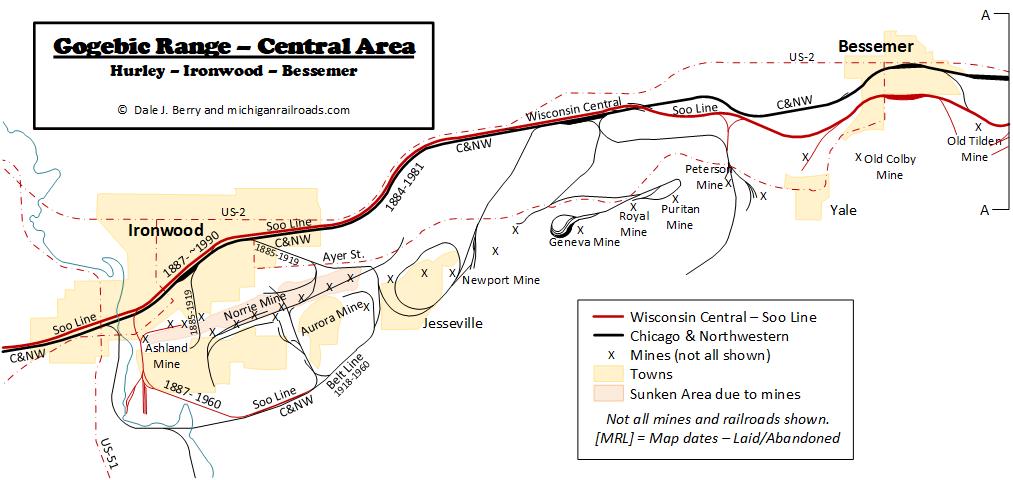
1887. The WC builds a 2.6 mile loop line from their main line (near the WI state line) towards the Norrie Mine, which has a number of mine spurs, including the Ashland Mine. The Ashland Mine was opened in 1901 and operated until 1926. The mine and town site was the second largest mine on the Gogebic range in 1902.
1887. The WC also builds a 3.5 mile spur off their main line at Bessemer to the Palms Mine. They build a 1.9 mile spur off of the Palms Mine spur to the Colby Mine and a 1.4 mile "switchback" to handle the hilly terrain.
1887. The first telephone service is created in Ironwood and Hurley. The Gogebic Range Telephone Company opened its first exchange in a Hurley residence. The first customers included the Montreal, Odanah, Ashland, Norrie, East Norrie, Aurora, Pabst and Iron King mines, as well as many local businesses. and the two railroads. The first lines were all "grounded" lines and some wires were strung on trees. The exchange moved to Ironwood in 1890 and the business was acquired by the Michigan Bell Telephone company later. Bessemer and Wakefield were connected and each community had a small central office. The Wakefield switchboard was crude and had a capacity of only 10 lines. In 1893, the 3 telephones in Bessemer and two in Wakefield were connected directly with the Ironwood switchboard. The first long distance trunk was established to Ashland in 1898, and east to Ewen and Marquette in 1905. [IDG-1963,0422]
1890. The MLS&W builds a spur from their main line to the Eureka Mine, about 1.1 miles long. The mine produces ore until 1950. It was north of Ramsey.
1892. The new Ironwood passenger station of the MLS&W railway is now a fact up to the sills of the windows on the first floor. The red brick with which the building will be made and the Lake Superior brownstone trimmings, will give the building a substantial and handsome appearance. [INR-1892-0924]
1893. The MLS&W becomes the Chicago & Northwestern railroad.
1893. The nationwide Panic of 1893 reduces iron ore sales and production for several years.
1895. The C&NW builds a short spur to the Mikado Mine, using a switchback to climb the hilly area. This branch is removed in 1919.
1896. The C&NW builds a spur to the Chicago mine, off the Connorsville spur. This spur is removed in 1915.
1897. The WC builds a 1.1 mile spur to the Norrie Mine, a half mile spur to the Aurora Mine, and a half mile spur to the Pabst Mine.
1900. The Meteor mine begins operation near Wakefield and produces until 1904.
1903. The C&NW builds a spur from the Davis Mine spur to the Royal mine and the Geneva Mine.
1906. The Castile Mine near Wakefield opens and ships ore until its closing in 1923.
1909. The Wisconsin Central becomes the MStP&SSM, or Soo Line.
1911. The C&NW builds a spur to the Asteroid Mine, from their main line. They remove the 1.6 mile spur to the Norrie Mine.
1914. The C&NW builds a one mile spur to the Keweenaw Mine.
1916. The C&NW installs a short branch line to the Plymouth Mine in Wakefield.
1917. The C&NW builds a 1.4 mile branch line to the Wakefield Mine.
1918. The C&NW had telegraph operators here around the clock. [TRT]
1918. A spur is built by the C&NW to the Newport Mine, as well as a second spur to the same mine.
1918. The C&NW adds a Belt Line from nearly Hurley WI east across the state line to a junction with the Soo Line. (removed in 1957). They also build the Anvil Mine spur from their main line to the Anvil Mine in 1918.
1918. The C&NW builds a connection 4/10's of a mile in length, between the C&NW main line (at mp. 343.5 (0.2 miles east of Bessemer station) to the Soo Line.
1919. The Pabst Mine spur is removed by the C&NW.
1920. The Soo Line declines a request by the Ironwood Commercial Club to have a sleeper set out at Rhinelander to accommodate persons traveling from Ironwood to the Twin Cities, siting a shortage of equipment and especially sleeping cars. [IDG-1920-0310]
1926. The C&NW operates "the Skoot", a short passenger "gasoline coach" between Hurley, WI and Wakefield. In addition to the Skoot, a daily passenger train is run through Ironwood in each direction. [IDG-1926-1207]
1926. A man's claim against the C&NW was dismissed in favor of the railroad. The complaint of negligence was brought against the operator of the "skoot" for not taking more precautions at the crossing of the railroad tracks at Luxmore street in Ironwood. The man's own testimony showed contributary negligence when he testified that he had travelled the 100 feet between the Soo Line tracks and the Northwestern tracks without looking to see if any cars were coming. [IDG-1926-1207]
1928. The Ironwood city commission has appointed a committee to investigate radio interference here. Meanwhile, acting on the suggestion of persons who identified interference as coming from the click of telegraph keys at local railway offices, the North Western and Soo Line railroads promptly remedied the situation. But there is much work to be done before the radio interference level is lowered. Poor bonds on the street railway system may be responsible for some. "Flasher cigar lighters" may need 'interference preventers' as the layman might call them. And the trouble may be due to any number of appliances in the home. Radio reception of late has been good and there have been fewer complaints. [IDG-1928-1207]
1932. Edwin Johnson sustained fractures of both upper and lower jaws and a possible skull fracture when the automobile he was riving crashed into a signal pillar at the railroad crossing on Lake Street. He was brought to Runstorm's hospital for treatment. [IDG-1932-0808]
1932. The Soo Line issued an order effective today dispensing with the second trick operator at the local depot here and as a substitute for this job a caretaker will be hired. The operator will move to a different town. [IDG-1932-1201]. Ed. Note: This might refer to Mellon, WI, the article was unclear.
1933. Twenty-four switch engine crews were working on the North Western and Soo Line railroads today, principally engaged in the handling of ore shipments. Twenty of these crews were at work on the North Western. [IDG-1933-0824]
1934. Four men who were taken into custody while occupying a caboose in the Soo Line railroad yards pleaded guilty to charges of vagrancy in municipal court and were sentenced to serve 90 days each in the county jail. [IDG-1934-1208]
1941. Forty skiers from Chicago were welcomed into "Ironwood in White" at 8 o'clock this morning on the week-end sky train sponsored by the Chicago & Northwestern railroad company and the Chicago Herald-American - the first ski train in Ironwood for the winder. [IDG-1941-0222]
1945. The C&NW and MStP&SSM employ 55 yardmen and 20 trainmen in ore service, which is pooled. [MPSC-1945]
1945. About half of the Connersville branch is removed, with the remainder removed in 1974.
1946. February. The C&NW announces they will resume providing Pullman sleeping car service as of Friday, February 15. The first sleeper will be on the southbound Ashland Limited to Chicago. The service had been discontinued a year earlier when the government requisitioned all Pullmans for use in troop transportation except on runs of more than 400 miles.
1947. Ore trains are made up by the mine run assignments. The C&NW usually ran about 125 to 150 car ore trains. The car factor was 50 loaded cars to each F-7 diesel locomotives. Four F-7's were put together for trains of up to 180 cars. (Steam power formally handled 80-0 cars and up to six crews per day).
1948. People living in the vicinity of the C&NW roundhouse and marshaling yards appeared before the city commission to learn what progress had been made on the problem of lessening the smoke and soot nuisance attributed to the railroad. No progress was noted but the city commission asked the people to "give us another chance" to work it out with the railroad. [IDG-1948-0810]
1950. The C&NW spur to the Asteroid mine is removed.
1952. The Wakefield mine spur and connections are removed, as well as the Plymouth mine spur.
1955. The C&NW spur to the Eureka mine is removed.
1955. The last steam locomotive switch engine of the Soo Line railroad left Ironwood Saturday and was replaced by a diesel locomotive. [IDG-1955-0208]
1956. A Soo Line bridge and building crew reinstalls the railroad car weighing scale just east of the Ironwood depot. The 300,000 lb. capacity scale was torn down in January and parts were sent to the factory for reconditioning and rebuilding. The scale is used to weigh all commercial business including iron ore which is shipped by rail. The scale was last rebuilt in 1916. [IDG-1956-0329]
1957. The Keweenaw Mine spur (C&NW) is removed.
1959. The remainder of the Sunday Lake spur from Wakefield to the mine is removed. The New Davis mine spur is removed one year later.
1963. The spurs to the Newport mine and Newport No. 2 mine are removed.
1964. Harry Mockross is retiring after more than 48 years of service with the Soo Line. He put in his last day of work as the agent at the Soo Line freight depot here. He noted that the Soo Line took off its last local commercial switch engine here today, at least temporarily. He said the company will try a tri-weekly service, with an engine coming from Ashland to do the switching in this area on Mondays, Wednesday's and Fridays. [IDG-1964-1030]
1965. The old Soo Line railroad depot on Frederick St. between Suffolk and Lowell streets, more than 70 years old, is being torn down and replaced by a new and smaller building. The new building will be 16'x36' in size. The building will house the Soo Lin office presently located in the old building. [IDG-1965-0716]
1965. The Peterson Mine spur is removed, as well as the Puritan Mine and the Royal/Geneva mine spur.
1970. Thieves have removed an unused copper telephone line along the Soo Line railroad right of way east of Ironwood. This is a part of a series of copper thefts in the region according to State Police. [EDP-1970-1123]
1981. The C&NW removes it remaining railroad lines from the Ironwood area.
 Photo Info: A "birds eye" view of Ironwood in 1886.
Photo Info: A "birds eye" view of Ironwood in 1886.
Bibliography
The following sources are utilized in this website. [SOURCE-YEAR-MMDD-PG]:
- [AAB| = All Aboard!, by Willis Dunbar, Eerdmans Publishing, Grand Rapids ©1969.
- [AAN] = Alpena Argus newspaper.
- [AARQJ] = American Association of Railroads Quiz Jr. pamphlet. © 1956
- [AATHA] = Ann Arbor Railroad Technical and Historical Association newsletter "The Double A"
- [AB] = Information provided at Michigan History Conference from Andrew Bailey, Port Huron, MI

